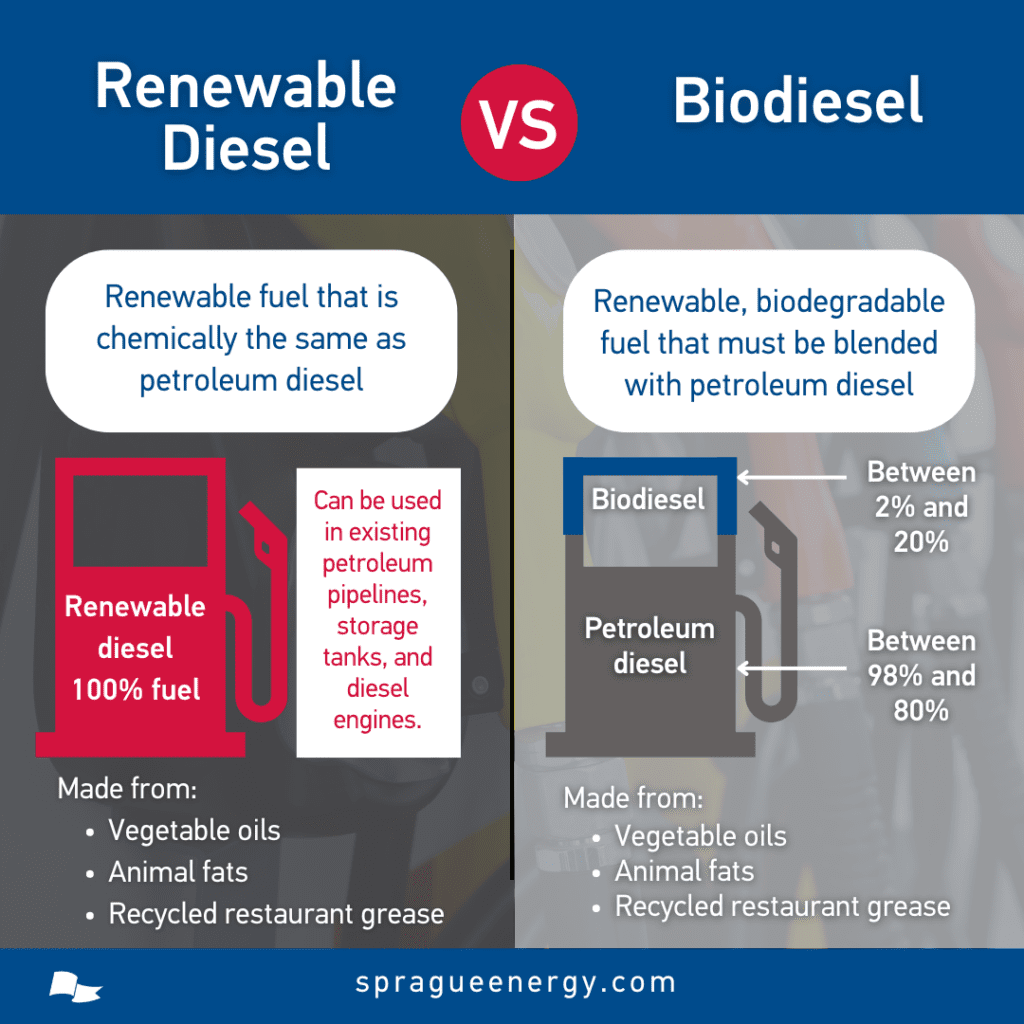In the quest for sustainable energy solutions, renewable diesel and biodiesel have emerged as two prominent biofuels. While they are often confused due to their similar origins and goals, renewable diesel and biodiesel largely differ in their production processes and chemical properties. This blog post will delve into these differences, helping you understand which fuel might be the better choice for different applications and your business sustainability goals.
Renewable Diesel: The Drop-In Fuel
Renewable diesel is an advanced low carbon liquid fuel designed to significantly reduce emissions. It is derived from renewable feedstocks such as used cooking oil like soybean and corn oil, and fats. While both renewable diesel and biodiesel are produced for renewable feedstocks, the key difference is how they are chemically produced and converted. Renewable Diesel production occurs through hydrotreating and isomerization. The feedstocks are then converted into pure diesel hydrocarbons. Fun fact: renewable diesel is chemically the same as petroleum diesel!
The Benefits:
Here is where the ‘drop-in’ part comes in: renewable diesel can be used at 100% rate, meaning it requires no blending and no infrastructure changes to your vehicle. RD is high cetane, meaning it works faster and burns cleaner than other diesel fuel, while also being colorless, odorless, and serving as a stable fuel option. As we continue to expand RD availability throughout our footprint, we’re not only lessening negative impacts on the environment, you don’t have to compromise on your fleet performance in order to meet your sustainability goals.
Some common questions may be:
Can I fill up my truck with renewable diesel?
The answer is: yes! This fuel can be added to any diesel engine, or even blended with traditional diesel. No infrastructure changes involved.
Who can use renewable diesel?
Any vehicle or fleet with a diesel engine. Whether you are in the construction industry, public transportation, fuel trucks for home heating, etc., this serves as a cleaner fuel option for you to run on.
How credible is renewable diesel?
Renewable diesel meets ASTM D-975 specifications and has been approved for use by major original equipment manufacturers (OEMs).
To stay up to date on where you can fuel up with this sustainable fuel, visit our Renewable Diesel page today!
Biodiesel: The Versatile Blended Fuel
Biodiesel is a clean-burning alternative fuel that, like renewable diesel, is also sourced from renewable feedstocks. This renewable and biodegradable fuel can be blended based on application need, whether it be for diesel engines or home heating. Depending on the state and other factors, the use of biodiesel may be tax-exempt. Through the chemical conversion process of transesterification, feedstocks are converted into fatty acid methyl esters, also known as FAME. While renewable diesel is chemically the same as petroleum diesel, biodiesel must be blended with petroleum, typically between 80-98%. Bio-blends can range from 2% to 20%.
The Benefits:
In addition to sharing the RD benefits such as reduction in greenhouse gas emissions, high cetane rating, and improved lubricity ensuring minimal upkeep and no infrastructure or engine modifications, biodiesel is also known for its various blend options. Different states hold various mandates for different percentages of bio-blends, and percentages will continue to increase as the years go on. Take a look at some current state mandates in the Northeast:
- New York: New York City and certain other parts of the state have implemented mandates requiring the use of B5 (5% biodiesel) in heating oil, known as Bioheat, with plans to increase this blend percentage in the future. (New York State Senate Bill 2021-S3321A).
- Massachusetts: Requires a minimum biodiesel blend of B5 (5% biodiesel) in any diesel-powered vehicle that is owned or operated by the state. (Executive Order 594, 2021)
According to sHB-6412, the state of Connecticut is under the following blend requirements effective July 1st of each applicable year, as shown below:
- 5% in 2022
- 10% in 2025
- 15% in 2030
- 20% in 2034
- 50% in 2035
Some common questions may be:
Is biodiesel a fossil fuel?
No, biodiesel is a clean-burning alternative fuel that contains no petroleum, but can be blended with petroleum diesel.
What are the different biodiesel blend options?
There are various biodiesel blends that are typically with petroleum diesel, such as B2, B5, B20, and even B100 which is pure biodiesel. Reach out to your account manager to discuss customizable blends!
How do I know what blend to use?
Different fleets may decide their bio-blends based on application need, climate, and state requirements. You can check your state’s current requirements by visiting sites such as energy.gov and searching your state.

By partnering with Sprague, we focus on staying ahead of the mandates, so you can focus on keeping your customers fueled and happy. While some of these dates may seem far away, each state has different blend requirements, so it is crucial to stay informed of your state’s mandates if you rely on biodiesel.
We’re proud to offer a variety of options and customized blends to our customers. Whether you go for renewable diesel or biodiesel, our team is here to assist you every step of the way as the market evolves and state mandates come into effect.
Visit our Wholesale Fuel page today to further explore our service options: https://www.spragueenergy.com/wholesale-fuel/










